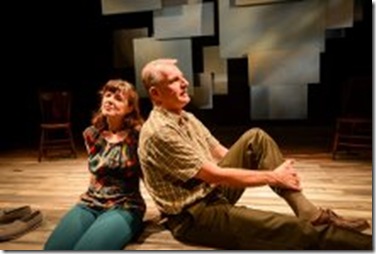The Boy in the Moon. A whispered confession transformed into a play is a difficult challenge for the GCTC
Photo. Andrew Alexander
The world premiere of The Boy in the Moon is playing now at the GCTC theatre. Directed by Eric Coates, this is the stage adaptation of Canadian journalist Ian Brown’s well-known memoir, The Boy in the Moon. Playwright Emil Sher has adapted the memoir, which chronicles Brown’s experience raising a son, Walker, who was born with a rare, genetic condition that renders him mentally delayed, non-verbal, and physically handicapped. It is first and foremost a touching story, and Sher’s theatrical adaptation picks up on bold questions about the value of their son’s life, and the ever-present questions the Browns have about the nature of Walker’s inner-world. The question of Walker’s “inner-world” is a thread that Sher weaves throughout the script. The story is told by the characters of Ian and Johanna on stage, played by Peter James Haworth and Manon St. Jules, respectively. Sher uses Brown’s book as a point of departure, and bolsters the script through interviews conducted with Ian and Johanna.
It is documentary theatre, and employs a naturalistic dialogue between Ian and Johanna as well as depictions of memories, which are aided through the use of a third actor, played by Marion Day. Yet, one hopes that in a documentary-style theatre that the play is, in itself, self-reflexive. There is a layer of semiotics—that is, system of symbols—that separates the subject of a play from the playwright. Here, the script fails to achieve that self-awareness. The result is a play that is a fairly straight-forward, over-sentimentalized version of a memoir. The pace of the script is as such that frenetic memories are punctuated by a “turning point”, or realization. The cycle is repeated until the end, and so these “turning points” lose impact.
The stage is fairly bare and gives an overall impression as an abstract depiction of a room. Two rows of overlapping canvases, hung from the ceiling, are used as large, textured projection screens onto which sketches of photos of Walker appear. These sketches pick up on a significant theme in the play: Walker’s inability to communicate, and his drive to self-harm leave Ian and Johanna yearning to see below the surface of the son they love.
There is something fundamentally off about the choice of tone and direction of the play. Ian and Johanna speak with a matter-of-fact, dry humour that calls to mind Stuart McLean on the Vinyl Cafe. It is dissonant with the content of this documentary-style piece, in which Brown offers us his measured confessions. The story is undeniably touching and the production will likely move you to tears, but the story and direction are at war.
Brown’s memoir is a whispered confession. The nature of memoir—both in its authorship and in our reading of it—is quiet and intimate. “Quiet and intimate” are achievable on stage, but it is something that director Eric Coates struggles with in this production. The “whispered confessions” are instead trumpeted by the characters, and so the characters come across as one-dimensional. Picture an artist who paints only with one, very big brush. That is an apt analogy for Coates’ treatment of the script.
In one instance, Johanna delivers an aside: She meets a woman whose developmentally delayed daughter passed away at 14 years of age. The woman says, “Do you know the first thing I did—on the way back from the funeral? I said to my husband, ‘Pull over. Let’s have sex.’” Johanna’s character delivers this line with a wry, knowing, elbow-nudge that lands an awkward silence. It was palpably the wrong approach to the slow decay in intimacy that Johanna and Ian experience as they attempt to understand and care for Walker.
Nevertheless, the subject matter creates a strong foundation for all these artists to stand. The struggles Ian and Johanna experience come across as universal—and even relatable. The result is an impactful play which meditates on the nature of being, and particularly, of parenthood.
